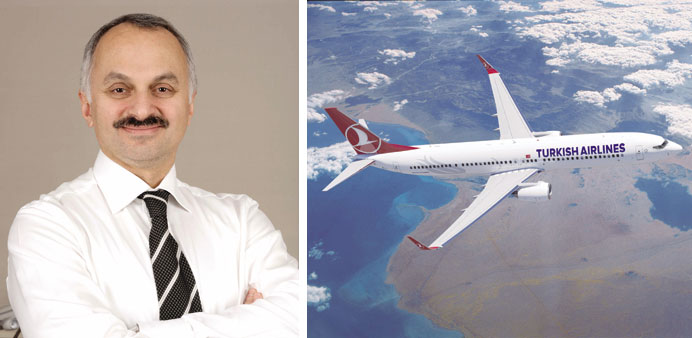Temel Kotil: the chief executive (left). The company plans to enlarge its fleet to 293 aircraft from 263 currently, and by 2023 the aim is for 450 planes.
By Lena Klimkeit and Can Merey/Istanbul/ DPA
Behind the panoramic window of Temel Kotil’s Istanbul office, Turkish Airlines planes take off to destinations all over the world. The chief executive has lined up along the window sill the flags of all 109 countries that the national carrier flies to.
Little lights on a huge map of the world show the cities that the fleet flies into. The collection of flags is growing steadily, and a new light is added to the map every couple of days.
Turkish Airlines says it now flies to more international destinations than any other airline. The airline - a member of the Star Alliance that includes Lufthansa, All Nippon Airways, Air China and Air Canada - is putting pressure on Europe’s established carriers.
Competitors are watching with growing concern as the carrier, which was privatised under Kotil in 2006, extends its reach. In addition, Istanbul is being expanded into one of the world’s major hubs.
Its emblem - a stylised white bird on a red background - has become well known, not least in Germany, where Turkish Airlines is a sponsor of the Bundesliga football club Borussia Dortmund.
Kotil says part of the reason for the airline’s success is the service offered, which it has insisted on maintaining in the face of the economic crisis.
“In the crisis we put more food on the table,” he says. Kotil even intends to provide a dedicated lounge for Economy passengers on long-haul routes in the new airport.
Kotil has built the airline into a major player on the international aviation stage.
Presenting himself in a low-key style, the 55-year-old chief executive tells the company’s story in a voice so soft that it is sometimes difficult to hear what he is saying, even though his enthusiasm is unmistakable.
Kotil comes from a village in the Rize region on the Black Sea coast that is best known for its fisheries. After studying aeronautical engineering at Istanbul Technical University, he took his doctorate in the US in 1991.
The chief executive - he has held the post since 2005 - presents a pile of graphs all showing rapid growth over recent years. The airline now flies to 223 international destinations, with its modest prices along with its huge network drawing an increasing number of passengers in transit.
In 2014, the airline more than doubled its profit to around $240mn.
The company plans to enlarge its fleet to 293 aircraft from 263 currently, and by 2023 the aim is for 450 planes.
There is no place for the huge Airbus A380 in Turkish Airlines’ plans, Kotil says, preferring to use smaller planes to fly to popular destination several times a day - for example Berlin, which is serviced five times a day.
The airline flies to a host of smaller European destinations, with the result that passengers fly all over the world from them via Istanbul.
There are plenty of lights on Kotil’s map representing European and Asian airports, and in the Americas San Francisco has recently been added as an 11th destination.
Turkish Airlines is also flying to a number of African cities, and the chief executive has major plans here as well, pointing to a growing middle class on a continent of more than abn people and rich in natural resources.
The Turkish government has also helped through its policy of international engagement to prepare the way for the airline to open up new destinations in Africa.
And as European countries delay much needed airport expansion plans, Ankara has backed the construction of the Istanbul New Airport intended to check in its first passenger in 2017.
The aim is for the hub, covering 7,600 hectares, to handle as many as 150mn passengers a year. By comparison in 2014, London’s Heathrow handled 73mn passengers, Charles de Gaulle in Paris 64mn and Germany’s Frankfurt 60mn.
Kotil sees huge hubs like this as the future, predicting that airports could go to 10,000 hectares. “That’s the size of the future,” he says.



